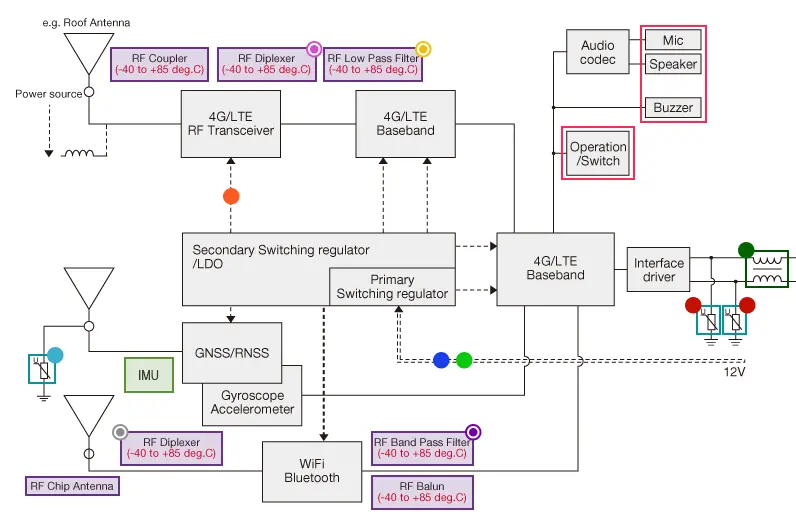Source: TDK tech note
The evolution of sensing technology and communication network contribute to the realization of Autonomous driving society and its growth. In association with full-scale expansion of the “5G service” next-generation wireless communication standard, great attention is being placed on wireless technology intended for “vehicle-to-vehicle and infrastructure-to-vehicle communication” (V2X) to communicate data between automobiles and their surroundings. This article provides brief overview of Inductors and high-frequency passive components use in Telematics Control Units (TCUs).
Telematics Control Units (TCUs)
The Autonomous Driving society is coming to the reality in order to reduce the number of casualties caused by traffic accidents and improve the level of convenience of mobility services. In addition to cameras, millimeter-wave radar, and LiDAR, autonomous vehicles must be equipped with communication functions provided by equipment known as Telematics Control Units (TCU), devices which communicate with vehicles using wireless methods to exchange vehicle-to-infrastructure and vehicle-to-vehicle information.
TCUs include GNSS (Global Navigation Satellite System), cellular and Wi-fi antennas, and IMUs (Inertial Measurement Units). These IMUs use methods such as SLAM (Simultaneous Localization and Mapping) and “dead reckoning” (estimated navigation) which can detect precise vehicle positioning if GNSS signals are interrupted by tunnels, overhead crossings, underground locations, high-rise buildings, or other shielding conditions.

Figure 1. V2X-Telematics Control Unit Block Diagram (Source: TDK Application Guide)
IMUs (Inertial Measurement Units)
IMUs (Inertial Measurement Units) are combined devices which integrate 3-axis gyro sensors and 3-axis acceleration sensors for detecting precise vehicle positioning into a single chip, and are able to achieve the highest level of performance in the industry with outstanding noise characteristics, temperature stability, sensitivity, and precision. These properties are key elements for the development of applications including navigation, Telematics Control Units, and locators. Furthermore, these products are equipped with advanced programmable multi-interface devices which can be supplemented with external sensors such as pressure gauges and barometers.
High-Frequency RF Products – Automotive Chip Antennas/Filters, Baluns, Diplexers, and Directional Couplers
During autonomous driving, automobiles must have wireless connections established using cellular signals or DSRC connection and perform two-way infrastructure-to-vehicle and vehicle-to-vehicle communication to detect obstacles or other approaching vehicles which cannot be seen, and TDK’s ANT antenna series can serve to support this in-vehicle connectivity. The ANT series of ceramic chip antennas is characterized by a compact, low-profile design achieved through a unique structure which uses low-temperature co-fired ceramics (LTCC) technology. Products in the ANT series are small and thin with no loss of performance or reliability, contributing to reduced space requirements with an antenna area among the smallest in the industry and allowing significant simplification and efficiency improvement during board revisions at each stage of board design and development.
In addition to chip antennas, TDK’s lineup includes filters, baluns, diplexers, and directional couplers. Please use these products according to the operating temperature ranges indicated in their catalogs, specifications, and other materials, and inquire with us for further details.


































